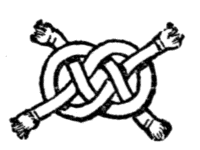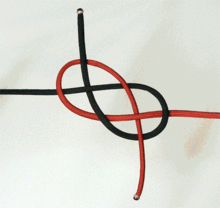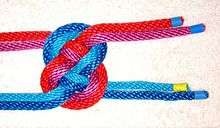Carrick bend
| Carrick bend | |
|---|---|
 A fully interwoven diagonally opposed carrick bend | |
| Names | Carrick bend, Double carrick bend, Double coin knot, Ten accord knot, Bosun's knot, Basketweave knot, Chinese knot, Josephine knot, Whistle lanyard, Sailor's breastplate knot, Sailors knot, Pretzel knot, Wake knot |
| Category | Bend |
| Related | Single carrick bend, Diamond knot, Carrick mat |
| Releasing | Non-jamming |
| ABoK | #1428, #1439 |

The carrick bend is a knot used for joining two lines. It is particularly appropriate for very heavy rope or cable that is too large and stiff to easily be formed into other common bends.[1][2] It will not jam even after carrying a significant load or being soaked with water.[3] As with many other members of the basket weave knot family, the carrick bend's aesthetically pleasing interwoven and symmetrical shape has also made it popular for decorative purposes.
The knot features prominently as a motif in the hard science fiction novel Picoverse by Robert A. Metzger.
Heraldry
In heraldry, this known as the "Wake knot" or "Ormonde knot", due to being used as a heraldic badge of various families.[4]
Etymology
This knot's name dates back to at least 1783, when it was included in a nautical bilingual dictionary authored by Daniel Lescallier.[1][5] Its origins prior to that are not known with certainty. There are several possible explanations for the name "Carrick" being associated with this bend. The Elizabethan era plasterwork of Ormonde Castle in Carrick-on-Suir shows numerous carrick bends molded in relief. Or the name may come from Carrick Roads—a large natural anchorage by Falmouth in Cornwall, England. The name may also have been derived from the Carrack, a medieval type of ship.[6]
Variations
The eight crossings within the carrick bend allow for many similar-looking knots to be made. The lines in a "full" or "true" carrick bend alternate between over and under at every crossing. There are also two ways the ends can emerge from the knot: diagonally opposed or from the same side. The latter form is also called the double coin knot. The form with the ends emerging diagonally opposed is considered more secure.[1]
Unfortunately, with so many permutations, the carrick bend is prone to being tied incorrectly.[3]
Appearance
Capsized

The carrick bend is generally tied in a flat interwoven form as shown above. Without additional measures it will collapse into a different shape when tightened, a process known as capsizing, with the degree of capsizing depending on the looseness of the weave. This capsized form is both secure and stable once tightened, although it is bulkier than the seized form below. Incomplete capsizing resulting from a tight weave produces a form that is likewise secure and stable, but which is more difficult to untie, countering one of the advantages of the carrick bend. When the knot is allowed to capsize naturally under tension, considerable slippage of line through the knot can occur before tightening, so the knot should be set carefully before loading to avoid this slippage in use.[7]
Seized

In the interest of making the carrick bend easier to untie, especially when tied in extremely large rope, the ends may be seized to prevent the knot from collapsing when load is applied. This practice also keeps the knot's profile flatter and can ease its passage over capstans or winches.[8]
The ends are traditionally seized to their standing part using a round seizing. For expediency, a series of double constrictor knots, drawn very tight, may also be used.[2] When seizing the carrick bend, both ends must be secured to their standing parts or the bend will slip.
Decorative uses

In the decorative variation, both standing ends enter from one side and both working ends exit from the other. In this configuration the knot is known as the Josephine knot (macrame) or double coin knot (Chinese knotting). This form of the carrick bend is found depicted in heraldry, sometimes with the tails of heraldic serpents woven (or "nowed") into this knot.[9] In heraldry the knot is associated with Hereward the Wake and is known under the name Wake knot.[6] It is depicted in the coat of arms of Bourne Town Council, Lincolnshire.[10]
The knot can be tied using doubled lines for an even flatter, more elaborate appearance. A doubled carrick bend was used to ornamentally secure the lanyards on the breastplate of the US Navy Mark V diving helmet during inspection and between dives.[11][12]
When the ends of the carrick bend are connected together, or more practically hidden behind the knot, it becomes a carrick mat. This same configuration is also one of the most basic Turk's head knots.
Security
The fully interwoven diagonal carrick bend is the most secure variation. All other forms are inferior[3] and not recommended as bends.[1]
Although the carrick bend has a reputation for strength, some tests have shown it to be as weak as 65% efficiency.[1]
See also
References
- 1 2 3 4 5 Geoffrey Budworth, The Complete Book of Knots (London: Octopus, 1997), 43.
- 1 2 Brion Toss, Chapman's Nautical Guides: Knots (New York: Hearst Marine Books, 1990), 79–80.
- 1 2 3 Clifford W. Ashley, The Ashley Book of Knots (New York: Doubleday, 1944), 262–263.
- ↑ Arthur Charles Fox-Davies, A Complete Guide to Heraldry (1909), p. 469.
- ↑ Lescallier, Daniel (1783), Vocabulaire des Termes de Marine: Anglois et François, London: P. Elmsly
- 1 2 Geoffrey Budworth, The Ultimate Encyclopedia of Knots (London: Hermes House, 1999), 60–61.
- ↑ Cyrus Lawrence Day, The Art of Knotting and Splicing, 4th ed. (Annapolis: Naval Institute Press, 1986), 58.
- ↑ Des Pawson, Pocket Guide to Knots & Splices (Edison, NJ: Chartwell Books, Inc., 2002), 114-115.
- ↑ J.C. Turner and P. van de Griend (ed.), The History and Science of Knots (Singapore: World Scientific, 1996), 388.
- ↑ "Image: bourne.JPG, (256 × 404 px)". civicheraldry.co.uk. Retrieved 2015-09-02.
- ↑ Davis, RH (1955). Deep Diving and Submarine Operations (6th ed.). Tolworth, Surbiton, Surrey: Siebe Gorman & Company Ltd.
- ↑ Stillson, George D (1915). "Report in Deep Diving Tests.". US Bureau of Construction and Repair, Navy Department. Technical Report. Retrieved 2009-06-03.
External links
- Grog. "How to tie the carrick bend". Animated Knots.
- "L8a8 (mathematical "link" topologically equivalent to seized carrick bend of practical knot-tying)", The Knot Atlas.
- Animated carrick bend video and step by step process.